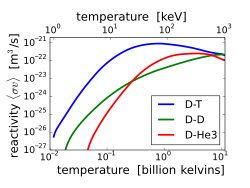Fusion power
Nuclear fusion is when two atoms merge to form a new one. This reaction with plasma generates energy. The idea behind a fusion reactor is to build a nuclear power plant that uses this process to produce electricity. Nowadays, nuclear power plants use nuclear fission to produce energy. Nuclear fission is not the same as nuclear fusion.
Nuclear fusion is the same type of process the Sun uses to generate heat. The most powerful nuclear weapons also use fusion.
No commercial power plants use this technology; there are a few academic ones; these include the Joint European Torus, in England. This reactor uses a principle called Tokamak. A tokamak uses magnets arranged in a doughnut shape to squish the atoms together. Another kind uses laser fusion, also called inertial confinement fusion.
Fusion Power Media
The Sun, like other stars, is a natural fusion reactor, where stellar nucleosynthesis transforms lighter elements into heavier elements with the release of energy.
Binding energy for different atomic nuclei. Iron-56 has the highest, making it the most stable. Nuclei to the left are likely to release energy when they fuse (fusion); those to the far right are likely to be unstable and release energy when they split (fission).
The fusion reaction rate peaks with temperature within the Gamow window. Modern tokamaks achieve ~8 keV (100 million kelvin). At these temperatures the D-T reaction is ~100 times more favourable than others.
Approaches to fusion, in color coded families: Pinch Family (orange), Mirror Family (red), Cusp Systems (violet), Tokamaks & Stellarators (Green), Plasma Structures (gray), Inertial Electrostatic Confinement (dark yellow), Inertial Confinement Fusion (ICF, blue), Plasma Jet Magneto Inertial Fusion (PJMIF, dark pink).
Parameter space occupied by inertial fusion energy and magnetic fusion energy devices as of the mid-1990s. The regime allowing thermonuclear ignition with high gain lies near the upper right corner of the plot.
The Electra Laser at Naval Research Laboratory demonstrates 90,000 shots in 10 hours, repetition needed for IFE power plant.
Diagram of the D-T reaction







